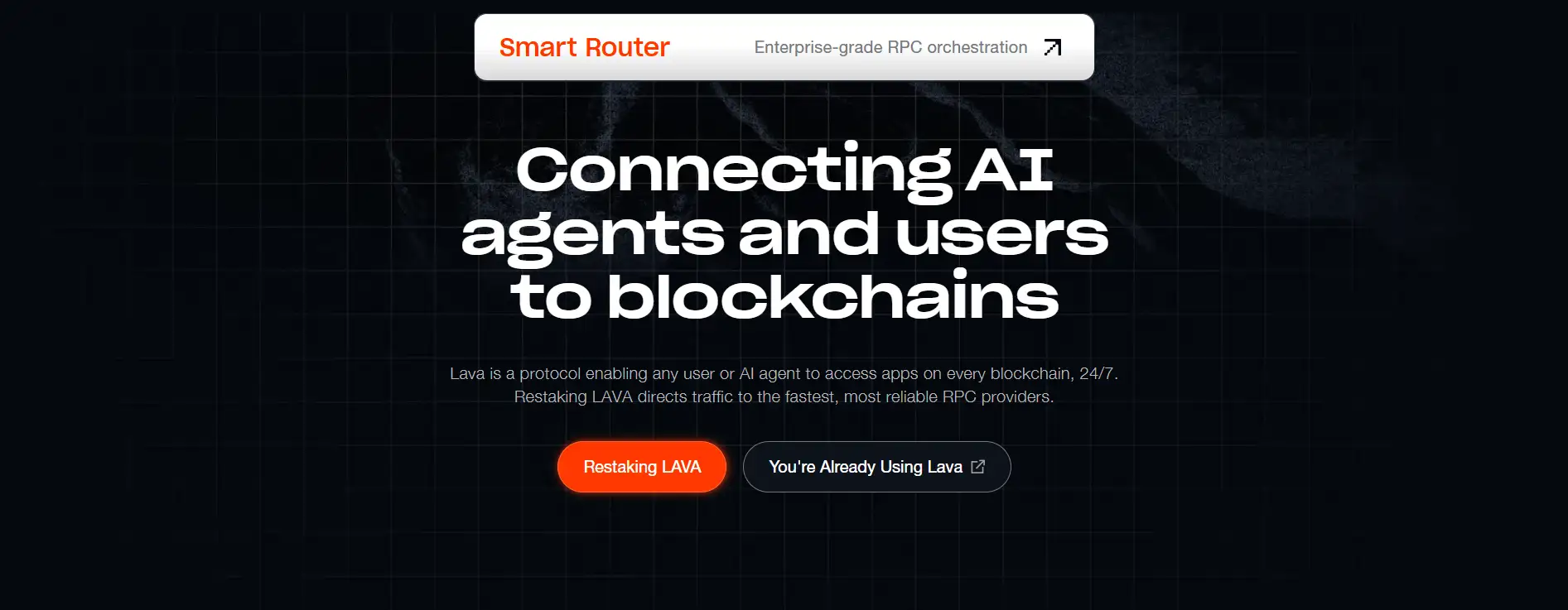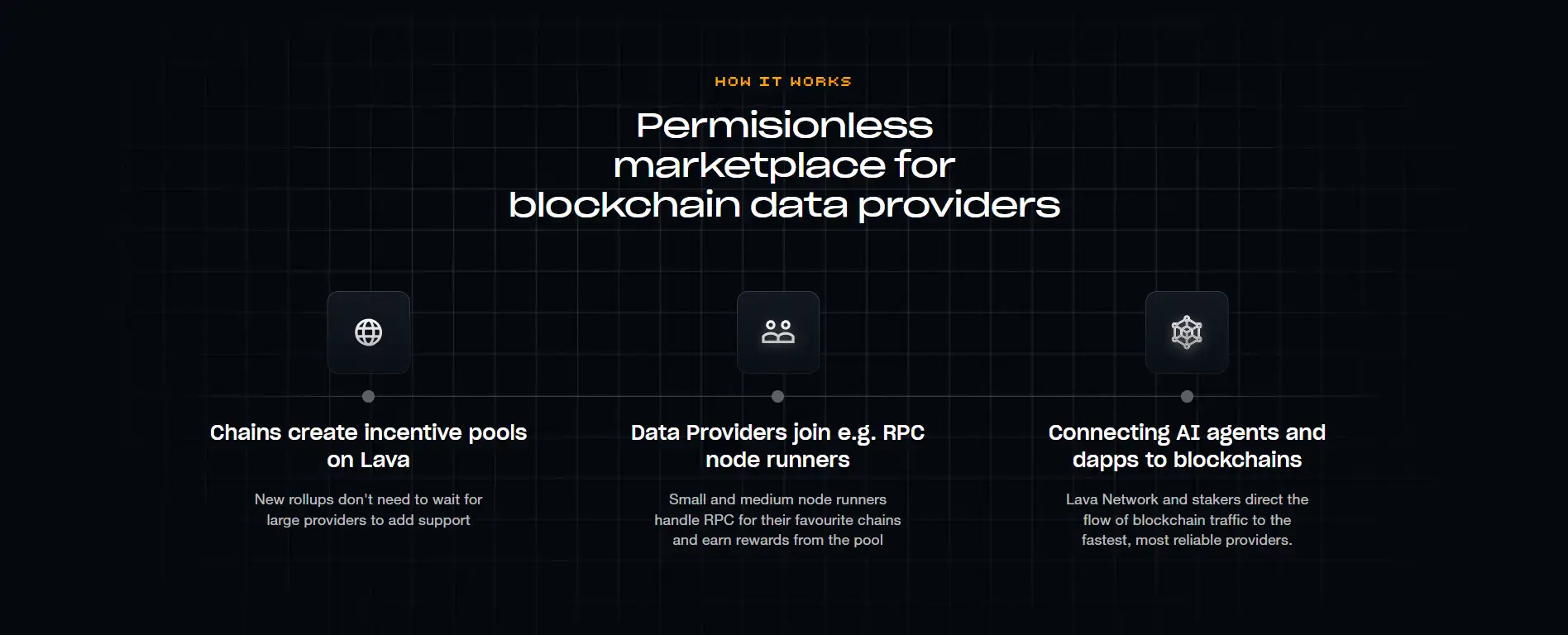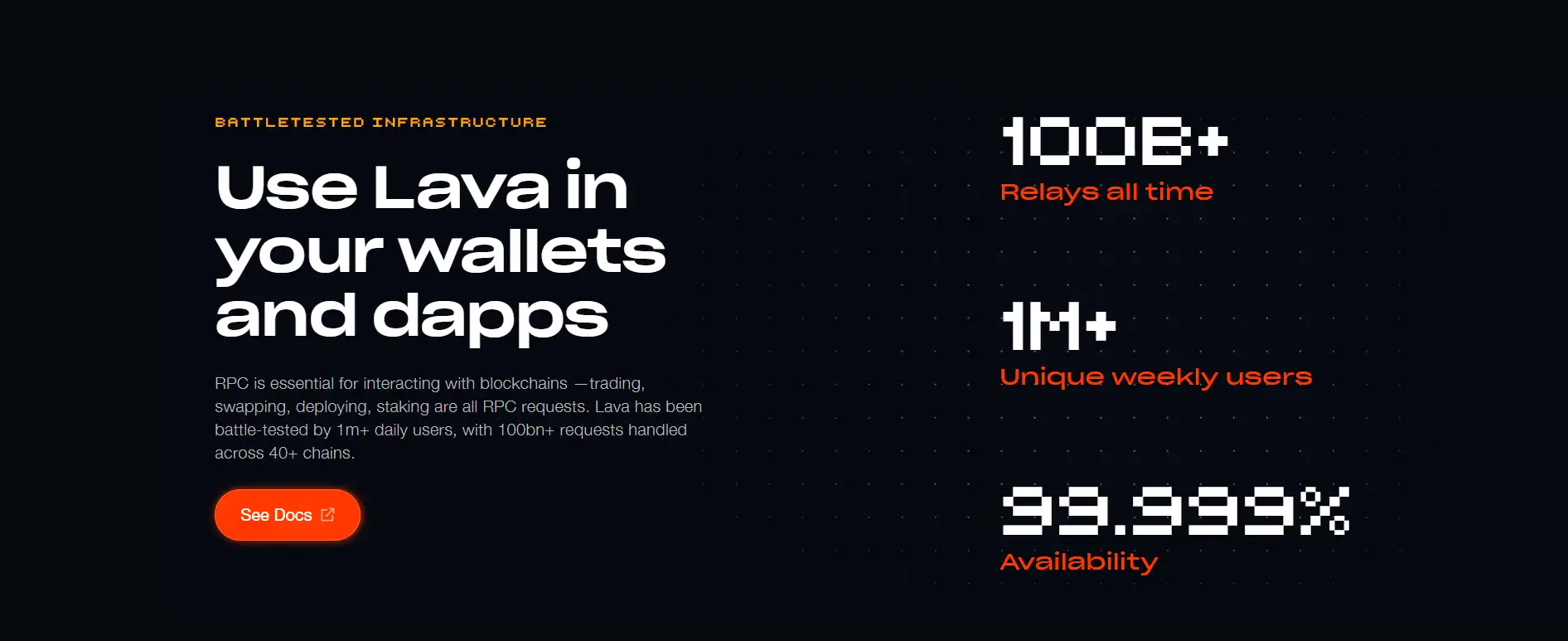About Lava Network
Lava Network is a comprehensive decentralized RPC protocol built to connect AI agents, dapps, and end users to apps on every blockchain, 24/7, with ultra-reliable performance. The protocol coordinates a permissionless marketplace of data providers and intelligently routes requests to the fastest, most reliable nodes using its Smart Router and incentive pools. In practice, this means that activities like trading, swapping, staking, deploying smart contracts, and other blockchain interactions are processed seamlessly with minimal latency and near-perfect uptime.
By enabling restaking of its native LAVA token, the network allows holders to direct blockchain traffic to the highest quality RPC providers, ensuring optimal service for consumers. Lava Network already supports 40+ chains and has handled over 100 billion relays, serving more than one million unique weekly users. Its mission is to deliver the infrastructure layer that keeps the decentralized web connected, scalable, and reliable — a critical foundation for the future of Web3 and AI-powered blockchain applications.
Lava Network was designed to solve one of the most critical problems in blockchain — reliable, scalable, and decentralized RPC (Remote Procedure Call) infrastructure. In Web3, every transaction, data fetch, and smart contract execution depends on RPC. Without it, wallets, decentralized exchanges, and AI-powered applications cannot function. Traditionally, access to RPC services has been centralized, creating bottlenecks, single points of failure, and limitations for smaller blockchain networks. Lava changes this by offering a permissionless, decentralized marketplace where node runners, developers, and validators participate in delivering high-quality RPC services.
The network is built to handle massive scale. It has already processed more than 100 billion relays across 40+ supported blockchains with a proven uptime of 99.999%. These blockchains include both high-traffic ecosystems and emerging networks, allowing Lava to serve as a universal RPC gateway for all kinds of decentralized applications. It’s been battle-tested by over 1 million unique weekly users, demonstrating its resilience and ability to meet real-world demand.
One of Lava’s key innovations is its incentive pool model. Partner chains like NEAR, Starknet, Filecoin, and Axelar can create dedicated pools to reward high-performance RPC providers, which helps bootstrap support for new networks without requiring massive centralized infrastructure. This design benefits both small and large node runners, enabling them to compete on quality rather than scale alone.
The network’s Smart Router ensures that every request — whether from a human user or an AI agent — is sent to the fastest, most reliable provider in real time. Quality of Service scores, provider reputation systems, and cryptoeconomic mechanisms like slashing and jailing maintain service reliability. Additionally, restaking allows LAVA token holders to actively direct network traffic to top providers, improving decentralization while rewarding performance.
In the broader landscape, Lava Network competes with or complements other decentralized infrastructure providers such as Pocket Network, Chainstack, and QuickNode. However, its multi-chain focus, built-in incentive mechanisms, and AI compatibility give it a distinct position in the market. Its mission is not just to serve existing blockchain ecosystems, but to enable entirely new ones to flourish without infrastructure barriers.
Lava Network offers a set of benefits and features that position it as a core pillar in the Web3 infrastructure ecosystem:
- Ultra-Reliable RPC Services: With 99.999% uptime and a proven track record, Lava ensures continuous connectivity for wallets, dapps, and AI agents.
- Multi-Chain Support: Currently supports 40+ blockchains and scales rapidly to integrate new networks through its incentive pool model.
- Smart Routing: Routes blockchain traffic to the fastest and most reliable providers in real time, optimizing user experience.
- Permissionless Participation: Open to node runners, developers, and validators without central gatekeeping.
- AI Integration: Built with native compatibility for AI agents to interact with decentralized apps seamlessly.
- Incentive Pools: Partner blockchains can create reward pools to attract quality RPC providers, supporting smaller networks.
- Restaking Mechanism: Token holders can restake LAVA to direct traffic to top providers and earn additional rewards.
- Battle-Tested Scale: Over 100 billion requests processed with more than 1 million weekly users.
To start using Lava Network and tap into its decentralized RPC infrastructure, follow these steps:
- Visit the Website: Go to Lava Network to explore available services, documentation, and ecosystem roles.
- Access Endpoints: Developers can obtain RPC endpoints via the Lava Gateway or use LavaSDK to integrate directly into their applications.
- Join as a Data Consumer: If you operate a dapp, wallet, or AI service, connect to Lava’s network to enjoy low-latency, high-availability blockchain access.
- Become a Data Provider: Node runners can join the protocol to serve RPC requests, earn rewards, and build their reputation.
- Stake or Restake LAVA: Participate in securing the network, direct traffic to top providers, and earn validator and provider rewards.
- Engage with the Community: Join Lava’s Twitter to stay updated and collaborate with other ecosystem participants.
Lava Network FAQ
The Smart Router in Lava Network continuously monitors latency, uptime, and accuracy metrics for all connected RPC providers. When a request is made, it dynamically routes traffic to the fastest and most reliable node available at that moment. This decision-making process is powered by real-time Quality of Service scores and a provider reputation system, ensuring every request is handled with maximum efficiency.
Yes — AI agents can connect directly to Lava Network through its LavaSDK or ipRPC endpoints. This allows them to perform blockchain actions like trading, staking, or data querying without downtime. The protocol’s low latency and Smart Router ensure that AI-driven transactions and data requests are executed as quickly and reliably as possible, even across multiple chains simultaneously.
Incentive pools allow emerging blockchains to deposit rewards — often in their native tokens — into Lava Network. These rewards attract skilled node runners and RPC providers to support the chain. As a result, smaller or newer blockchains don’t have to wait for large infrastructure providers to add support, enabling them to offer reliable RPC services from day one.
Restaking in Lava Network allows token holders to delegate their stake to top-performing RPC providers. This not only secures the network but also directs blockchain traffic toward providers with the best performance metrics. Restakers earn additional rewards, while the network benefits from higher service reliability and reduced latency.
Lava Network achieves its 99.999% uptime through a combination of distributed infrastructure, redundant RPC providers, and real-time routing. If one provider fails or slows down, the Smart Router instantly shifts traffic to another high-quality provider. This design, combined with slashing penalties for poor performance, ensures uninterrupted service for wallets, dapps, and AI agents.
You Might Also Like












